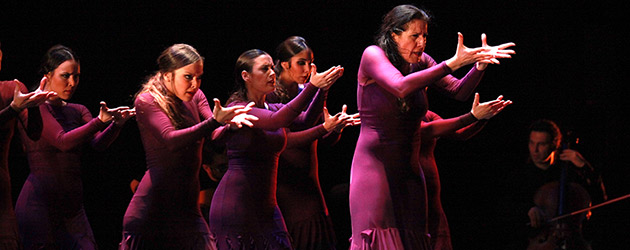Text: Estela Zatania
Photos: Ana Palma
María Pagés «Yo, Carmen»
Samuel Serrano, Joaquín de Sola
Wednesday, February 25th, 2015. Jerez de la Frontera
Special 19th Festival de Jerez – All the information
MARÍA PAGÉS, A BRAND-NAME UNTO HERSELF
SAMUEL SERRANO, JOAQUÍN DE SOLA.
Palacio Villavicencio, 700pm
Video Samuel Serrano – Video Joaquín de Sola.
And then they tell us young people aren't interested in classic flamenco singing. The ages of Samuel Serrano and Joaquín de Sola, from Chipiona and Cádiz respectively, barely add up to 45 years. Samuel, related to the Agujetas family, has the corresponding repertoire and delivery, and a voice as gut-wrenching as theirs. He began directly with tonás, and all the fury of the San Miguel neighborhood of Jerez. With the guitar of Paco León from Puerto de Santa María, also very young, he sang soleá, siguiriyas and bulerías. In the second part of this shared acoustic recital, we were able to enjoy the singing of Joaquín de Sola. His repertoire is classic, but his way of singing is all his own, with surprising melodic turns in malagueñas, alegrías, soleá de Cádiz and bulerías, and accompanied on guitar by Víctor Rosa.
MARÍA PAGÉS «YO, CARMEN».
Teatro Villamarta,900pm
Dance: Maria Pagés, Isabel Rodríguez, María Vega, Natalia González Alcalá, Lucía Campillo, Sonia Franco, Macarena Ramírez, Paco Berbel, José Antonio Jurado. Cante: Ana Ramón, Loreto de Diego. Guitar: Rubén Levaniegos, José Carrillo «Fyty». Percussion: Chema Uriarte. Cello: Sergio Menem. Violin: David Moñiz. Idea, director and choreogrphy: María Pagés.
Out in front of the Villamarta Theater, a half hour before the performance of María Pagés, the broad plaza was like an itinerant market with stands of accessories and CDs, and the aggressive distribution of publicity for various enterprises related to flamenco and tourism. It's the Pagés effect. Wherever María is, there are crowds, because she has been an undisputed international star for years.
But I'll be darned if I get this thing about the «premieres». This work of Pagés, «Yo, Carmen», I could swear a large part of it is recycled unchanged from earlier work by this dancer. Especially the drawn-out beginning with off-stage voices in a variety of languages, the presence of books and the same poetry that spoke of the futility of wanting to possess things…it was like a really long déjà vu. I looked around, but saw no one appeared surprised that from a new work which premiered in October, not only were entire segments lifted from a previous one, but now the same scenes have a completely different meaning in the context of the work: in this case, the scene which last September opened the «world premiere» of the work «Siete Golpes y un Camino» intended as a retrospective of María's carreer, has now been re-purposed as a feminist anti-«Carmen» message. It's when I start to think if people might not be better off just dancing and getting on with it. At the time of that previous work (the premiere of the premiere of «Yo, Carmen»?), I wrote the following which continues to be relevant: «No sound-check can guarantee the correct amplification of [the off-stage voice] which so rarely accomplishes its mission. The poetry of María Zambrano and others could not be appreciated. For the serious flamenco fan, the work would have been enhanced with less attention to the literary aspect, and more to the dancing».
But we must be indulgent with María Pagés, she is a great artist, a brand-name unto herself. Her concepts of choreography and staging are original, clever and nearly always efficient. She makes little use of flamenco singing, but knows how to take advantage of the lovely voices of Ana Ramón and Loreto de Diego. She likes jersey double-knit for costumes, «like the extension of our skin» she says. And she tends to use neutral tones and colors in order to highlight with electric red the elements she considers especially significant. All this is in «Yo, Carmen».
There is a fascinating play of white fans with a black background, and many musical fragments from Bizet's «Carmen». Also, a tanguillo-rap that María always enjoys doing, in addition to a farruca, soleá apolá (quite the fashion in this Festival de Jerez) and her alegrías. María's dancing is not based on sharp tricks or clever surprises, quite the contrary…hers is dance based on fluid harmonious movements.
A possible overload of group choreographies gave a certain flatness after a while; I suspect María Pagés' numerous fans would have liked to see her do more solo work.
